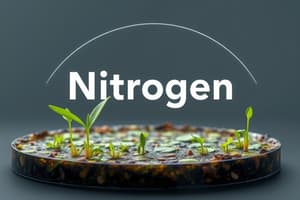Podcast
Questions and Answers
Why is nitrogen essential for living organisms?
Why is nitrogen essential for living organisms?
- It readily reacts with other minerals to form oxides.
- It is the primary gas used in respiration.
- It directly fuels metabolic processes.
- It acts as a building block for all living organisms. (correct)
Plants can directly absorb nitrogen gas (N₂) from the atmosphere.
Plants can directly absorb nitrogen gas (N₂) from the atmosphere.
False (B)
Name three types of bacteria that aid in nitrogen fixation.
Name three types of bacteria that aid in nitrogen fixation.
Nitrosomonas, Nitrobacter, Azotobacter
The process where iron reacts with oxygen to form rust is an example of forming an ______.
The process where iron reacts with oxygen to form rust is an example of forming an ______.
Match the following gases with their primary role in the environment:
Match the following gases with their primary role in the environment:
Which of the following is the most reactive gas and readily forms oxides?
Which of the following is the most reactive gas and readily forms oxides?
Ozone is solely beneficial in all atmospheric layers due to its UV ray absorption.
Ozone is solely beneficial in all atmospheric layers due to its UV ray absorption.
List three major anthropogenic contributors to increased carbon dioxide levels in the atmosphere.
List three major anthropogenic contributors to increased carbon dioxide levels in the atmosphere.
The absorption of infrared radiation by CO₂ in the atmosphere leads to a phenomenon known as ______.
The absorption of infrared radiation by CO₂ in the atmosphere leads to a phenomenon known as ______.
Which effect of global warming directly leads to the eutrophication of oceans?
Which effect of global warming directly leads to the eutrophication of oceans?
Which of the following processes directly contributes to the formation of ozone (O₃) in the stratosphere?
Which of the following processes directly contributes to the formation of ozone (O₃) in the stratosphere?
Nitrogen can be directly absorbed and utilized by plants in its free gaseous form (N₂).
Nitrogen can be directly absorbed and utilized by plants in its free gaseous form (N₂).
Explain how increased levels of carbon dioxide (CO₂) in the atmosphere contribute to global warming.
Explain how increased levels of carbon dioxide (CO₂) in the atmosphere contribute to global warming.
The process by which certain plants, like leguminous plants, and bacteria convert nitrogen gas into usable forms is called nitrogen ______.
The process by which certain plants, like leguminous plants, and bacteria convert nitrogen gas into usable forms is called nitrogen ______.
Match the following gases with their approximate percentage in the atmosphere:
Match the following gases with their approximate percentage in the atmosphere:
Which of the following human activities is NOT a significant contributor to global warming?
Which of the following human activities is NOT a significant contributor to global warming?
The tropospheric ozone is considered beneficial because it absorbs harmful UV rays from the sun.
The tropospheric ozone is considered beneficial because it absorbs harmful UV rays from the sun.
Describe one way solar storms and coronal mass ejections (CMEs) can impact Earth.
Describe one way solar storms and coronal mass ejections (CMEs) can impact Earth.
Which atmospheric layer is characterized by vacuum-like conditions and extremely high temperatures (5000°C to 6000°C)?
Which atmospheric layer is characterized by vacuum-like conditions and extremely high temperatures (5000°C to 6000°C)?
Auroras, such as the Aurora Borealis and Aurora Australis, are formed when energetic solar particles collide with gases in Earth's atmosphere, causing the gases to emit ______.
Auroras, such as the Aurora Borealis and Aurora Australis, are formed when energetic solar particles collide with gases in Earth's atmosphere, causing the gases to emit ______.
Flashcards
Nitrogen (N₂)
Nitrogen (N₂)
A permanent gas making up ~78% of the atmosphere
Nitrogen Fixation
Nitrogen Fixation
The process of converting nitrogen into usable forms like nitrile, nitrate, or ammonia (NH₃)
Oxygen (O₂)
Oxygen (O₂)
Second most abundant gas in atmosphere (~21%), essential for respiration and combustion
Carbon Dioxide (CO₂)
Carbon Dioxide (CO₂)
Signup and view all the flashcards
Greenhouse Gases
Greenhouse Gases
Signup and view all the flashcards
Global Warming
Global Warming
Signup and view all the flashcards
Effects of Global Warming
Effects of Global Warming
Signup and view all the flashcards
Environmental Impact of Climate Change
Environmental Impact of Climate Change
Signup and view all the flashcards
Economic Impact of Climate Change
Economic Impact of Climate Change
Signup and view all the flashcards
Ozone (O₃)
Ozone (O₃)
Signup and view all the flashcards
Water Vapor
Water Vapor
Signup and view all the flashcards
Ozone Formation
Ozone Formation
Signup and view all the flashcards
Ionosphere
Ionosphere
Signup and view all the flashcards
Solar Storms (CMEs)
Solar Storms (CMEs)
Signup and view all the flashcards
Auroras
Auroras
Signup and view all the flashcards
Exosphere
Exosphere
Signup and view all the flashcards
Study Notes
Nitrogen (N₂)
- Nitrogen is a permanent gas that constitutes approximately 78% of the atmosphere.
- It serves as a vital building block for all living organisms including animals, plants, and fungi.
- Exists in forms such as free nitrogen gas (N₂), nitrogen oxides (NOₓ), and nitrogen hydrogen compounds (NH₃).
- It is non-reactive and freely available in gaseous form.
- Plants require nitrogen to be converted into nitrile, nitrate, or ammonia (NH₃) through nitrogen fixation, as they cannot directly absorb it.
- Leguminous plants such as pulses can independently fix nitrogen.
- Bacteria including Nitrosomonas, Nitrobacter, and Azotobacter aid in nitrogen fixation.
- Humans and animals acquire nitrogen through consuming plants or other animals.
Oxygen (O₂)
- Oxygen is the second most abundant gas in the atmosphere, making up approximately 20.8% to 21%.
- Highly reactive, readily forming oxides with minerals, such as iron to form rust (Iron Oxide) and aluminum to form Aluminum Oxide.
- Plays a crucial role in combustion, supporting fire.
- It is essential for respiration, which allows energy generation.
- Oxygen supports the metabolism of carbohydrates and fats.
Carbon Dioxide (CO₂)
- Carbon dioxide is a trace gas, present at approximately 0.03% in the atmosphere.
- It is a greenhouse gas that helps regulate temperature by absorbing heat.
- Plants use it in photosynthesis, along with chlorophyll and sunlight, to produce food.
- Absorbs infrared radiation, contributing to global warming by trapping heat, which increases global temperatures.
- CO₂ levels have risen from 280 ppm in the 1800s to 400 ppm in 2024.
- Primary causes of increasing levels include vehicular emissions, industrial pollution, thermal power plants, mining, and the burning of coal and fossil fuels.
- Melting glaciers, rising sea levels, increasing sea temperatures, coral reef death, and ocean eutrophication are effects.
Environmental, Economic, and Social Impacts of Climate Change
- Water body accumulation, climate pattern disturbance, and flora and fauna loss are effects.
- Agricultural productivity, income, taxes, GDP, and infrastructure development are economically affected.
- Includes risk of poverty, floods, and droughts.
- Drinking water accessibility, the fishing industry, farmers, tribes, women, children, tourism, and human development are socially affected.
Ozone (O₃)
- Ozone is a pungent gas that is harmful in high concentrations.
- It is found in the stratosphere, where it absorbs harmful UV rays "good" ozone.
- The troposphere has "bad" ozone, formed from hydrocarbons and pollutants.
- At an altitude of 50 km, oxygen (O₂) splits into O atoms due to UV rays, which then combine to form ozone (O₃).
Water Vapor
- Water vapor is a variable gas and the gaseous of water, originating from oceans, seas, water bodies, soil, plants, and vegetation.
- It traps heat, helping to regulate atmospheric temperature.
- At the Equator, it makes up 4% of atmospheric gases.
- At the Poles, the concentration is significantly lower at 0.02%.
- The majority of water vapor is concentrated within 6 km from the surface.
- Concentration decreases at higher altitudes
- Clouds, rain, fog, frost, mist, cyclones, and tornadoes are linked to water vapor.
Structure of the Atmosphere
- The atmosphere stretches between 16,000 and 28,000 km from Earth’s surface.
- The first 80 km are most relevant for scientific studies.
- 50% of the atmospheric mass is concentrated in the first 5.5 km.
Ionosphere and Solar Activity
- The ionosphere interacts with solar flares and affects radio wave transmission
- Communications systems can be disrupted by solar flares.
- Solar storms and coronal mass ejections (CMEs) disturb radio waves and GPS signals.
- Solar particles react with Earth’s magnetic field and atmosphere, creating auroras.
Auroras: Formation & Mechanism
- Energetic solar particles collide with gases in Earth's atmosphere
- Gas molecules are excited, lose energy, and emit photons of light, resulting in auroras.
- Aurora Borealis, or Northern Lights, appear near the North Pole.
- Aurora Australis, or Southern Lights, appear near the South Pole.
Exosphere: The Outermost Layer
- The exosphere is a rarefied outer atmosphere with vacuum-like conditions.
- Experiences extremely high temperatures, ranging from 5000°C to 6000°C
- Geostationary satellites orbit in this layer at approximately 36,000 km above Earth.
- It is the least explored atmospheric layer and is still being studied.
Studying That Suits You
Use AI to generate personalized quizzes and flashcards to suit your learning preferences.




